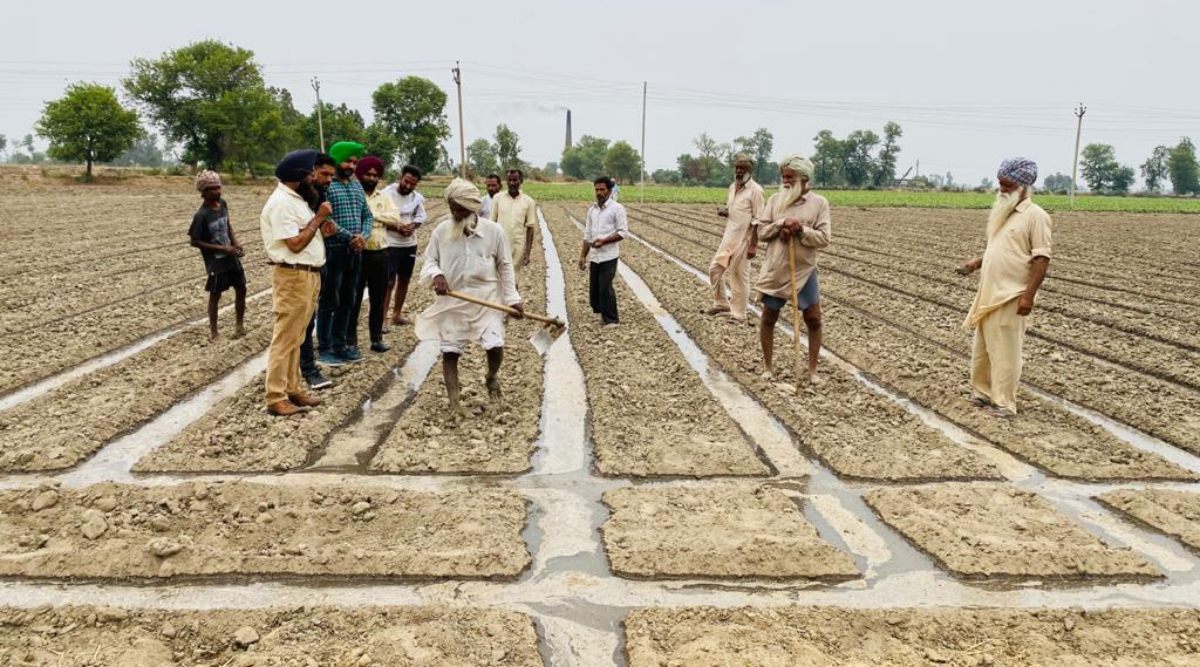 The cotton sowing season is currently underway in Punjab.
(Express Photo)
The cotton sowing season is currently underway in Punjab.
(Express Photo) Once a part of Malwa’s cotton belt, the farmers in Moga district of Punjab, slowly and steadily weaned away from this cash crop and drifted towards water guzzling paddy over the past two decades. The result was that last year in 2020, miniscule 150 hectares were under cotton cultivation in Moga, of overall 5 lakh hectares on which cotton was sown across the state.
In an effort to revive cotton cultivation in Moga and more so, to reduce pressure on water resources by weaning away farmers from paddy, the Punjab agriculture department has now started a unique project in the district under which farmers are being encouraged to sow cotton using ‘bed plantation technique’ — which uses furrow irrigation to save water. The cotton sowing season is currently underway in Punjab.
On Wednesday, the department officials sowed cotton on 7 acres owned by a farmer Balbir Singh from village Nidhan Wala in Moga-2 block, using this technique. Till now 25 acres have been sown in this particular block in different villages with the same technique as a demonstration to encourage other farmers to adopt cotton cultivation instead of paddy, said Dr Jaswinder Singh Brar, assistant plant protection officer, Moga.
Brar said that this year, their target is to bring at least 800 hectares under cotton cultivation in the district and farmers are being encouraged to adopt this technique.
“In early 1990s, at least 15,000 hectares in Moga used to be under cotton but slowly, farmers stopped growing it. Last year, just 150 hectares were under cotton. We have started this project to revive cotton in Moga because not only will it save water, but it will also lead to diversification if farmers shift from paddy to cotton,” he said.
Explaining the technique, Brar said that 4-feet wide beds are created in soil using tractor-operated bed planters and the spaces between those beds are called ‘furrows’. “Seeds have to be sown on beds and they have to be irrigated by filling water in those furrows only. The furrow irrigation technique not only saves water but also saves up to 30 per cent water and increases the yield up to 15 per cent,” says Dr Brar.
Among the many benefits of furrow irrigation and bed plantation technique are: water conservation, timely sowing, early germination of seeds and it even averts waterlogging of fields in case of excess rainfall. “If there is excess rainfall, which otherwise can destroy the crop (if sown traditionally on flat fields), furrows avert waterlogging as excess water can be drained out. Bed plantation also prevents weed growth,” said the officer.
Till early 1990s, cotton was among the main kharif crop in south western districts of Punjab including Bathinda, Mansa, Moga, Fazilka, Muktsar, Barnala, Sangrur and Faridkot — and together the area was known an ‘cotton belt’ of Punjab — with these districts having naturally fit soil as well as climatic conditions for the crop.
“In 1980-90, there even used to be a cotton research station at Raunta village of Nihal Singh Wala block in Moga which was run by Punjab Agricultural University (PAU). But slowly as farmers drifted away from cotton, the station premises was handed over to agriculture department by the varsity and now it is used as a seed farm for wheat and paddy crops,” said Brar.
Due to severe attack of insects, pests and other diseases, farmers left sowing cotton and diverted towards paddy due to factors such as MSP, subsidy on machines, free power etc. The aim is to revive cotton sowing again in Moga district as once it was a part of Punjab’s cotton belt,” he said.
- The Indian Express website has been rated GREEN for its credibility and trustworthiness by Newsguard, a global service that rates news sources for their journalistic standards.

